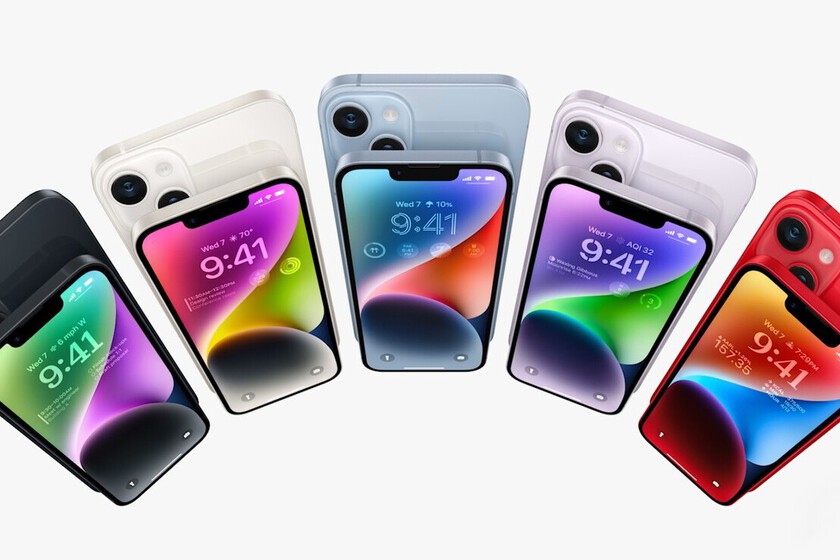iPhone 14 Pro and Pro Max, comparative: this is how they are compared to Google Pixel 6 Pro, Galaxy S22+, Xiaomi 12 Pro and the rest of high-end Android

The new iPhone 14 are already here. Gone are the days when Apple launched a new iPhone every year: we have four new models. The most powerful -and without a notch- are the iPhone 14 Pro and iPhone 14 Pro Max, which will go head to head with the high end of Android.
To know how the last ones are iPhone 14 Pro and iPhone 14 Pro Max vs. high-end Androidwe have faced Android terminals with similar characteristics: Google Pixel 6 Pro, Samsung Galaxy S22+, OPPO Find X5 Pro, OnePlus 10T, Realme GT Neo 3 150W, Xiaomi 12 Pro and Sony Xperia 1 IV.
The compact option remains
The iPhone 14 Pro and iPhone 14 Pro Max keep a lot of their specification sheet from each other, but their main difference is pretty obvious: size. The iPhone 14 Pro with its 6.1-inch OLED screen is compact if we compare it with Android mobiles it is equivalent.
On high-end Android mobiles what they take is the 6.7 inches, the same diagonal of the iPhone 14 Pro Max. The small screen also translates into a small body: no Android phone in a similar range comes close to the 147mm height and 71mm width of the iPhone 14 Pro.

The closest thing is the Samsung Galaxy S22 + with its 6.6-inch AMOLED screen and dimensions of 157.4 x 75.8 millimeters. In fact, even the iPhone 14 Pro Max with the 6.7-inch screen is more compact than the rest of Android phones with the same diagonal screen.
As for technologies, the truth is that there are not many differences. OLED and AMOLED prevail and also 120 Hzalthough somehow Apple has managed to mount panels signed by Samsung even brighter than those included by Samsung in its own phones.
You with an island and me with a hole

Probably the change that attracts the most attention of the iPhone 14 Pro and Pro Max is in its notch or, rather, in the absence of it. From the tab attached to the top we go to two perforations displayed as one, with all kinds of tricks and animations to camouflage the area and make it useful. Don’t call it a notch, call it an island.
Of course, you won’t find anything similar on Android, since no high-end mobile in our comparison has a secure facial recognition system equivalent to Face ID. With a single front camera in all cases, it is to be expected that simple drilling prevails in Androidmore discreet than the island of the iPhone 14 Pro, but without animations.
These perforations are in the center in all cases except for the OPPO Find X5 Pro and the Realme GT Neo 3 150W, which have it on one side. The Sony Xperia 1 IV goes it alone again and mounts the camera on the top frame.
Processors of all colors

Year after year, Apple manages to get the colors out of the rest of the processors with its Bionics, and although we remain pending the benchmarks of the day, it is to be expected that the same will be repeated this year. Unlike the iPhone 14 and 14 Plus that stay as they are, the iPhone 14 Pro and 14 Pro Max make the leap to new Apple A16 Bionic.
On Android mobiles the distribution of processors is increasingly divided. In a way, the Snapdragon 8 Gen 1 is the standard (and present in OPPO, Xiaomi and Sony models), while the Snapdragon 8+ Gen 1 is still somewhat more difficult to find and we only have it in the OnePlus 10T.
Like Apple, two Android brands bet on “their own processor”: Google uses its Google Tensor and Samsung the Exynos 2200 on the Pixel 6 Pro and Galaxy S22+ respectively. MediaTek is in the minority: we only see it on the Realme GT Neo 3 150W.
Fast charging lags behind

Apple has an unpleasant habit of keeping some technical details that it does not consider important to share, such as battery capacity or RAM memory. We will have to wait to know the specific figure, but in the meantime we can compare the fast and wireless charging of the iPhone 14 Pro. Technically it is fast, yes, but every time he knows us less.
The iPhone 14 Pro and Pro Max include support for 20W wired fast charging and wireless via MagSafe up to 15W. In wired charging, 20W is very little if we put it face to face with beasts like the 150W charging of the Realme GT Neo 3 and OnePlus 10T. Without going to extremes, even the moderate 30W of the Pixel 6 Pro or the Sony Xperia 1 IV are a significant increase.
In wireless charging there are not so many differencesWell, in some terminals like the OnePlus 10T or the Realme GT Neo 3 it’s not even there. Of course, it doesn’t know much either if we take into account that the iPhone 14 Pro starts at 1,369 euros, while the much cheaper Xiaomi 12 Pro mounts 50W fast wireless charging.
Apple catches up on megapixels

Apple had us accustomed to the trio of 12-megapixel Sony Xperia 1 lenses, but this year the bet is more similar to what we find in high-end Android phones, with the arrival of the 48-megapixel main sensor that will use the benefits of pixel binning to combine 4 pixels into 1 and improve luminosity, among others. This is something that in a certain way is the standard in Android and we have something similar in practically all the competition.
With a triad of main, telephoto and wide-angle sensor, the bet is almost similar to that of others such as the Galaxy S22 + (but without LiDAR), although remains somewhat more modest in resolution than high-end mobiles on Android.
In the high range of Android it seems that the fashion of putting megapixels raw in the main sensor has already passed, but in return we see more secondary sensors with 48 or 50 megapixelsas in the Pixel 6 Pro, OPPO Find X5 Pro or the Xiaomi 12 Pro. This speaking of the specification sheet, to see what these lenses are capable of we will have to wait for the reviews.
Comparison table
As always, we leave you the complete comparison table with all specifications of the terminals that we have included in our comparison. In this way, you can see at a glance how they are all alike and how they are different.
iPhone 14 Pro / Pro Max | Google Pixel 6 Pro | Samsung Galaxy S22+ | OPPO Find X5 Pro | OnePlus 10T | Realme GT Neo 3 150W | Xiaomi 12 Pro | Sony Xperia 1 IV | |
|---|---|---|---|---|---|---|---|---|
Screen | iPhone 14 Pro: 6.1″ OLED iPhone 14 Pro Max: OLED 6.7″ 2,566 x 1,179 | AMOLED 6.71″ | AMOLED 6.6″ | AMOLED 6.7″ | AMOLED 6.7″ | AMOLED 6.7″ | AMOLED 6.73″ | 6.5″ OLED |
Dimensions and weight | iPhone 14 Pro: 147.5 x 71.5 x 7.8mm and 206g. iPhone 14 Pro Max: 160.7 x 7.76 x 7.8mm and 240g. | 163.9 x 75.8 x 8.9mm | 157.4 x 75.8 x 7.6mm | 163.7mm x 73.9mm x 8.6mm | 163 x 75 x 8.75mm | 163.3 x 75.6 x 8.2mm 188g | 163.6 x 74.6 x 8.16mm | 165 x 71 x 8.2mm |
Processor | Apple A16 Bionic | google tensor | Exynos 2200 | Snapdragon 8 Gen 1 | Snapdragon 8+ Gen 1 | Dimension 8100 | Snapdragon 8 Gen 1 | Snapdragon 8 Gen 1 |
RAM | to be confirmed | 12GB | 8GB | 12GB | 8GB | 12GB | 12GB | 12GB |
Storage | 128GB | 128GB | 128GB | 256GB | 128GB | 256GB | 256GB | 256GB |
Frontal camera | 12MP | 11.1MP | 10MP | 32MP | 32MP | 16MP | 32MP | 12MP |
Rear camera | 48MP | 50MP | 50MP | 50MP | 50MP | 50MP | 50MP | 12MP |
Drums | to be confirmed | 5,000mAh | 4,500mAh | 5,000mAh | 4,800mAh | 4,500mAh | 4,600mAh | 5,000 mAh Fast charging 30W Wireless charging |
Others | FaceID | footprints on the screen | footprints on the screen | footprints on the screen | footprints on the screen | footprints on the screen | footprints on the screen | IP65/68 |
Price | iPhone 14 Pro: from 1,369 euros iPhone 14 Pro Max: from 1,469 euros | From 899 euros | From 1,059 euros | €1,299 | From 719 euros | From 699 euros | From 999 euros | From 1,399 euros |




